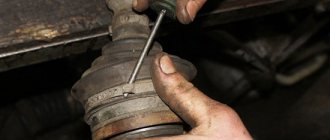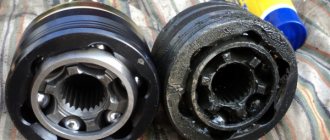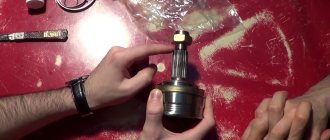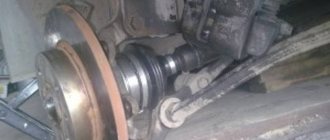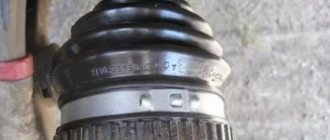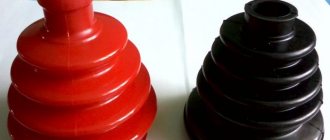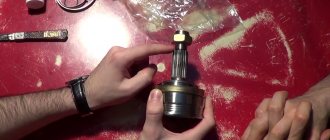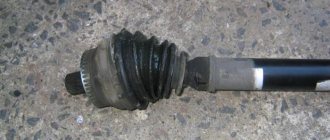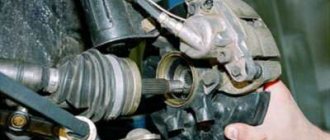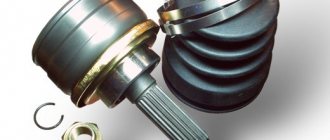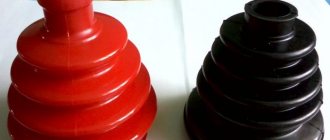Hello, dear subscribers and not!
Recently I decided to carry out a routine inspection of the chassis, and during this, cracks were discovered on the boot of the outer CV joint. And as everyone knows, after cracks, dust and dirt get into the CV joint housing, and this is a direct path to replacing the joint assembly, which is expensive and not justified. Therefore, in order to avoid this circumstance, I decided to quickly change it.
I’ll say right away that the material was taken from the Internet, because I simply don’t have the strength to describe everything myself (you’ll find out why later). I just edited it a little.
To perform this operation you will need the following tools:
17 mm wrench, 30 mm wrench, pry bar and wheel wrench.
Description of the work performed:
❶ Installed wheel chocks under the rear wheels and pulled out the parking brake lever. Having torn off the wheel mounting bolts, I jacked up the required side and placed a special support stand under the car. Finally unscrew the mounting bolts and remove the wheel. ❷ Use a screwdriver to pry it off and remove the protective cap.
That's it, the simplicity of the work ends here. My dad and I did this in 30 minutes. Next, it was necessary to remove the grenade from the drive shaft without removing the shaft from the gearbox. What happened next was just hell, I advise you to finish reading.
❻ Using a screwdriver, loosen the clamps securing the anthers. After removing the clamps, we cut the anthers, because they are no longer needed.
Now the most interesting thing is, we killed 4-5 hours of time!
❼ Using a special guide made of soft metal (for example, bronze) and a hammer (or a hammer with a bronze hammer), knock the outer and inner CV joints off the drive shaft.
We hammered for 4 hours, bitch, with a fucking hammer! 4! Then they both freaked out, went and bought a puller for 200 rubles. With a puller, they took it off in literally a minute or two.
❽ Then we washed the hinges using gasoline and diesel fuel. We checked the technical condition of the hinge elements. New boots were installed. We filled the CV joint housing with a special lubricant. We installed it on the drive shaft and, using a hammer, hammer the joint until the already replaced locking ring is fixed. Using a special tool, clamp the boot clamp on the drive shaft. Having placed the boot on the CV joint housing, pry it up with a screwdriver and squeeze it to release the air. Only after this do we install and tighten the fastening clamp. ❾ Next, install the drive shaft into the wheel hub and repeat all the operations described during removal in reverse order. After tightening the nut securing the drive shaft to the wheel hub, do not forget to lock it.
The main reason for the malfunction of CV joints (constant velocity joint) on Kalina is the depressurization of the CV joint boots. Initially, incorrectly installed anthers, or rather loosely tightened clamps and leaky or worn out anthers, do not provide a normal seal to the assembly. Water and dirt begin to get under them. Gradually, the lubricant turns into a rusty mess and ceases to perform its functions. The first sign of a faulty CV joint is a crunching sound in the area of the front wheel when the wheels are turned out when starting to move. In more advanced cases, such a crunch appears with less pronounced loads on the wheel.
Replacing the outer CV joint on a viburnum
Replacing the outer CV joint on a Lada Kalina car is not a serious problem. A person who has at least a minimal understanding of car repairs with their own hands can cope with this operation.
To replace the outer CV joint on the Lada Kalina we will need:
- Ratchet or crank
- Extension for extending a wrench or ratchet (a piece of pipe of suitable diameter will do)
- Head 17
- Head 30
- Hammer
- Jack
- Replacing the inner CV joint on a viburnum
LADA KALINA: Replacement of outer and inner CV joints
CV joint (constant velocity joint - approx.) or popularly just a “grenade”, is designed to transmit torque to the wheels of a car. CV joints can be internal or external, and the devices themselves are quite simple in technical terms and consist of a ball bearing that rotates transversely to its axis.
In the video, replacing CV joints on a Lada Kalina:
Failure of the CV joint on the Lada Kalina is a very common occurrence, and the main reason for its failure is torn anthers. Because, together with dust and water falling under them, the lubricant turns into thick mud, and it is no longer able to fully perform its functions.
Replacing the outer CV joint
In the process of replacing the outer CV joint
The work of replacing an outer or inner CV joint is not very difficult and can be done by any motorist who has at least once repaired a car with his own hands. And in order for the repair to be easier and faster, you need to prepare the following tools:
- Socket heads for “17” and “30”.
- Driver or ratchet.
- Extension for the wrench.
- Jack.
- Wheel chocks.
- Hammer.
- Vise.
Step-by-step disassembly procedure
After you are convinced of the malfunction of one or another CV joint, you can begin to work.
- First of all, we tear off the mounting bolts from the wheel and the hub nut, then we set the wheel chocks under the rear wheels. (To make it easier to tear off the nuts, it is better to use an extension for the wrench - approx.).
- We put the car on a jack and hang the wheel.
- We remove the wheel and, for greater reliability, place it under the car next to the jack.
- Now that this picture appears before you, all that remains is to unscrew the 2 bolts that secure the ball joint to the steering knuckle.
Unscrew the bolts marked with a red marker on both sides.
- When unscrewing the ball joint, apply force and use a wrench extension.
- Turn the steering wheel as far as possible to the side and slightly pull the steering knuckle with the stand and remove the outer part of the hub along with the CV joint (For convenience, you can make several gentle blows with a hammer - approx.).
- The next step is to dismantle the old boot and clamps. You shouldn't use them again; it's better to take a set of new ones.
- Next, you need to remove the CV joint itself.
If you have a special removable device, then use it. If not, then you will have to knock it out of place with a hammer. Without causing strong blows, the CV joint will move out of place - Hit the CV joint with a hammer, rotating it along the axle shaft. After some effort, the CV joint should give way.
If the internal CV joint is supposed to be replaced, then work 1 to 6 should be performed as well, after which, using a pry bar, we remove it from the gearbox and take out the entire assembly.
We take the inner CV joint assembled with the axle shaft to a vice where we clamp it and dismantle it.
- After the “bare” axle shaft appeared before us, the work on removing the CV joint can be considered completed.
Step-by-step assembly procedure
Work on assembling all parts should be carried out in the same order as removal, however, there are some nuances in these works.
- Then add lubricant to the CV joint.
New lubricant added to CV joint
All work on changing the CV joint, if the work is carried out correctly, will not take more than 1.5-2 hours. You can check the quality of the work performed immediately after the repair. If you start driving with the wheels turned to the side and there is no crackling, squeaking or noise, it means that the repair was carried out correctly and the car can be safely operated further.
Signs of CV joint failure
The first signs of a faulty grenade are crunching sounds in the area of the front wheel on turned out wheels when starting to move. When the fault is severe, noise appears at less significant loads.
The anther begins to “repair”
In order to prevent such damage in advance, you should periodically inspect the anthers from the outside for cracks and integrity in general.
Selection of CV joints
CV joint in original packaging. Usually inside the package is a pomegranate produced by VIS
Replacing the CV joint on Kalina
First you need to hang the wheel. Before putting the car on a jack, you need to remove the wheel bolts and the wheel nut. Using a wrench and a 30mm socket, we tear off the hub nut. To do this, it is better to extend the knob (for example, with a metal pipe of a suitable diameter). We unscrew the wheel bolts with a spray bottle. After we remove the wheel and nut, the following picture appears before us:
Now you need to unscrew the 2 bolts securing the lower ball joint to the steering knuckle. They are unscrewed using a ratchet or a wrench and a 17mm socket.
After we unscrew the ball from the steering knuckle, we have access to the CV joint. Now, by carefully hitting the CV joint (in the place where the hub nut was located) through the lining, so as not to damage the thread, carefully knock the CV joint out of the hub. For convenience, you can turn the wheels out.
Next, remove the boot. To do this, you need to remove the clamps and move the boot to the gearbox.
After this, you need to remove the CV joint itself. If you have a puller, use it. If there is no puller, then knock the grenade off the axle shaft with gentle blows of a hammer. We didn't have a puller and we knocked down the CV joint with a hammer. If the CV joint is “stuck” tightly and does not budge, then the seperator will need to be broken. With gentle blows of a hammer, preferably placing a rag on the separator (it is easily chipped and fragments can scatter throughout the garage or get into your eyes), apply blows while rotating the CV joint (For those who do not understand where to apply blows, they must be applied in the place where the the “balls” of the hinge themselves, we need to break this very hinge). The inside of the cage will remain on the axle shaft. To remove it, you must first remove the retaining ring:
How to replace the CV joint boot on a Lada Kalina
In order to simplify the replacement of the CV joint boot, it is better to carry out the work on the removed axle shaft.
- Tighten the handbrake and place chocks under the rear wheels. It is very important that the machine is parked on a level surface.
- We take the balloon and begin to remove the wheel. Don't rush to jack up the car; remove the bolts while the car is standing on four wheels. After this, you can jack up one side on which the work will be done. It is dangerous to work on a jack, so be on the safe side and place a block or metal jack under the car.
- If there are wheel arch liners, use a screwdriver to pry up the protective cap and remove them.
- We place a container under the drain hole of the gearbox, unscrew the plug and drain the transmission oil.
- Now we unscrew the fastening bolts, thanks to which the ball is attached to the steering knuckle - there are two of them.
- Unscrew the hub nut. To do this, you need to fix the hub; to do this, just press the brake pedal. Here you need to ask someone to press the brake pedal.
Basic information about LADA Kalina
LADA Kalina has been produced since 2004; production of the popular second-generation car began in 2013. Kalina-1 is available in three body types: hatchback (model 1119), sedan (model 1118), station wagon (model 1117). There are cars available with petrol engines of three modifications: a 1.4-liter 16-valve engine with a power of 89 hp. s., 1.6-liter 8-valve engine producing 81 hp. s., 1.6-liter 16-valve engine producing 98 hp. With. The LADA Kalina-1 has only a manual transmission with five gears. The front axle has a classic MacPherson suspension, the rear axle has a beam with stabilizer, springs, and shock absorbers.
Typical faults of LADA Kalina-1
Significant malfunctions with Kalina rarely occur, but there are a lot of various undesirable trifles. The car’s clutch is not very reliable and has an impressive service life, regardless of the type of engine, so it can malfunction after 40-50 thousand kilometers. The main source of malfunction is a broken clutch disc.
You need to constantly monitor the oil level in the engine - sometimes it leaks through the gaskets or burns through the piston rings. On the instrument panel there is only an oil pressure warning light, but there is no dial indicator. If the indicator lights up all the time, there is a possibility that the crankshaft is knocking.
A common malfunction of VAZ gearboxes is increased noise. It is difficult to get rid of the humming of the gearbox; sometimes neither replacing the bearings nor refilling with first-class transmission oil comes to the rescue. The transmission is noisy even in new cars, because of this the Volzhsky Automobile Plant has repeatedly completed the transmission.
A problematic element since the days of the VAZ 2108 and VAZ 2109 has been the thermostat in the engine, moreover, the valve in the thermostat was capable of jamming in any position. It's annoying when the engine doesn't heat up to the required operating temperature, but if the engine overheats, it's more problematic.
Electrical problems on LADA Kalina appear mainly of three types:
- the ignition module is often damaged;
- very soon the bearings and diode bridge “die”;
- The window lift cable on the driver's door breaks.
When the ignition coil sparks, the first and fourth cylinders or the second and third cylinders stop functioning. The ESP cable breaks when it falls off the guides.
The main source of cracking noise in outer CV joints is insufficient lubrication; At the factory, in order to save money, they put it in sparingly. The consequence of this is severe wear of the hinges, and as a result, the “grenade” needs to be replaced.
A broken timing belt is a very annoying problem. And if on the 8-valve engine 21114 it is possible to change the belt drive and move on, then on engines 11194 or 21126 the valves bend from the oncoming push from the pistons, repairs will be quite expensive. In addition, a break can occur through a jammed water pump, because of this, if the pump begins to make noise, it must be replaced immediately.
Do-it-yourself car repairs
“Kalina” is a simple car, so the driver can repair most of the damage himself. For example, you can fix the following problems on your own:
- change the engine air filter;
- remove air from the cooling system;
- change the water pump;
- eliminate the rattling of the gear knob;
- change the ignition module;
- replace the generator diode bridge;
- install a brand new outer CV joint to replace the crackling old one.
Repairing the LADA Kalina car yourself must be carried out in accordance with the instructions, using only good car mechanic tools, if you need to use special equipment and pullers for repairs.
How to change a constant velocity joint?
You can replace the outer CV joint in a Lada Kalina car without using a lift or pit, but you will need to place the car on a flat surface. Replace in this way:
- first you need to loosen the hub nut and unscrew it, because after removing the wheel it will become difficult to move the nut;
- loosen the wheel nuts, then use a jack to remove the wheel. In order to prevent the car from rolling, it is necessary to place stops under the rear wheels, and in front near the jack, for the purpose of reinsurance, place a support under the threshold (you can use a wooden block);
- unscrew the ball joint bolts at the bottom (two bolts);
- pull the steering knuckle towards you, release the wheel drive;
- remove the clamps from the boot;
- move the boot towards the gearbox, knock out the outer CV joint through a bronze or copper drift;
- put the new device in place, fill the joint with grease, fix the boot on the CV joint with new clamps;
- complete installation of all parts.
The procedure for replacing the boot
Replacing the outer CV joint boot on a Lada Kalina with your own hands, if you have the necessary tools and minimal skills, will take no more than 2-3 hours and will not cause any special problems.
Preparing the car
To carry out repairs, you need to place the Lada Kalina on a level surface, apply the handbrake and block the rear wheels with wheel chocks. Next, you should loosen the wheel bolts, use a flat screwdriver to remove the protective cap of the hub and use a 30mm socket with an extension to remove the hub nut. Then we lift the car on a jack and finally remove the front wheel.
Disconnecting the drive from the hub
Using a 17mm wrench, you need to unscrew the two bolts that secure the ball joint to the steering knuckle.
After this, unscrew the hub nut and remove the Lada Kalina thrust washer.
Then you need to turn the front wheels to their extreme position and remove the outer “grenade” from the hole in the hub. If the repair is carried out without assistants, first secure the drive axle shaft with wire to the car body to protect it from falling.
Dismantling the CV joint
Replacing the outer CV joint boot on a Kalina can be done directly on the car without disconnecting the axle shaft from the gearbox, which will avoid draining the transmission oil.
Unclench or cut off the clamps and move the rubber boot to the middle of the axle shaft. Then we dismantle the CV joint using a puller. You can do without it and carefully knock the hinge outward with a hammer through a wooden spacer. After this, remove the boot from the shaft.
Constant velocity joint diagnostics
Since the outer CV joint has been removed, the old grease should be removed and washed with gasoline, kerosene or another product for subsequent assessment of the condition. If the part has signs of wear, chips, cracks or play, it will need to be replaced.
Installing a new boot
First of all, we put a new boot on the axle shaft. To make replacement easier, you can lubricate the shaft with a small amount of grease. If the retaining ring was broken when removing the hinge, a new one should be installed in the groove of the axle shaft.
After this, a special lubricant is generously added to the CV joint, and its remains are applied inside the boot. "Grenade" ready for installation. Using gentle blows of a hammer on the shank of the CV joint through a wooden block, install the part onto the axle shaft until a characteristic click is heard.
Next, we put a protective boot and clamps on the hinge. We tighten one clamp and lightly squeeze the boot to remove air from it. Then fasten the second clamp on the other side. The boot replacement is complete.
Gearbox lever rattling
For LADA Kalina, a typical malfunction is rattling in the area of the gearshift lever, which mainly becomes noticeable when the engine is running at speeds of about 3000. The source of the side sound is the bushing, which is made a little thicker than necessary, and because of this, a gap appears in the mount. To resolve this problem you need to do the following:
- remove the handle cover, which is attached with latches;
- using two 13mm wrenches, unscrew the nut and bolt;
- remove washers and bushings;
- to eliminate rattling, the bushing in the middle needs to be slightly sharpened in width or the mount should be lubricated with sealant;
- Having done this, mount everything back. The sealant does not help out every time, but if you sharpen the bushing by 0.3 mm, the result is guaranteed.
It’s safe to say that repairing a Lada Kalina car yourself is not so scary. Every car enthusiast has the opportunity to eliminate minor malfunctions of this car. You just need to believe in yourself, follow our advice and everything will work out!
Front suspension CV joint design
The Lada Kalina car has front-wheel drive, which receives torque using a gearbox regardless of the angle of rotation. Front suspension drives (left and right) - consist of two working joints of equal angular velocities and a connecting shaft that provides connection between them. The left short shaft is made of a special steel bar, and the right long shaft is made of durable steel pipe. The shank of the inner joint housing is connected via a spline to the differential side gear. Torque is transmitted from the hinge to the drive shaft at the required angles. A feature of the design of the internal CV joint of the Lada Kalina is that, in addition to transmitting torque at several angles, it allows movement along the axis of the hinge body and the drive shaft of the suspension when moving.
With proper operation and timely maintenance of the vehicle, the joints can last up to 100 thousand km. According to statistics, external hinges are prone to failure more often than internal ones, which is primarily due to external factors.
Replacing a grenade on a Lada Kalina with your own hands
A constant velocity joint (CV joint) is a unit through which torque is transmitted from the transmission unit to the drive wheels. This device is also popularly called a “grenade”.
There are both external CV joints, which directly engage the wheel hub, and an internal CV joint, which is adjacent to the gearbox. Both hinges on one side of the car are connected to each other by a metal pipe, and the entire structure is called an axle shaft.
It happens that malfunctions appear, so many drivers are interested in how to change them.
The CV joint device is not particularly complicated. The unit includes a housing, a boot and a bearing, the separator of which is capable of rotating at different angles to the axle shaft, providing the ability to transmit rotation when the wheels are turned through the steering, therefore, using the tips, you can figure out on your own how to change the CV joint.
The video demonstrates the procedure for replacing the CV joint in the Lada Kalina chassis:
For models of domestic origin, including the Lada Kalina, failure of the hinge we are considering is a fairly common case.
The most common factor causing the breakdown of this unit is a torn boot.
This is due to the fact that dirt and moisture enter the working area of the hinge, eventually washing away the bearing lubricant, which causes wear and loss of functionality. And the outer CV joint needs to be replaced. You can do this procedure yourself.
Diagnosis of the condition of anthers
To check the serviceability of the car's boots, an external inspection is carried out and the condition of the front suspension components is diagnosed.
If there is no damage to the upper shell, there will be no traces of lubricant leaks on the surface of the boot and the car can continue to be operated in the same mode. It is advisable to carry out diagnostics regularly, which allows timely prevention of premature failure of CV joint mechanisms. When the vehicle accelerates rapidly, extraneous noise may occur in the front wheel sector, which may indicate an internal malfunction in the suspension components and require urgent diagnosis and repair with replacement of faulty parts.
Some of the main reasons for the failure of CV joint elements are:
- poor-quality lubrication or lack thereof due to boot failure;
- the presence of defective parts in the CV joint mechanism, as a result of which the seal of the boot is compromised;
- potholes and pits that form on the roadway, which leads to damage to the protection of the mechanisms and suspension elements of the car;
- energetic driving style, which leads to increased load and premature failure of units;
- destruction or violation of the tightness of the anthers during vehicle operation.
Video about replacing a grenade boot:
How to determine that the CV joint boot needs to be replaced?
The method is simple: you need to go to the pit and inspect the boot; if it is dry and no traces of oil are visible, then everything is in order and replacement is not required yet.
If, after checking, you find that there is a malfunction and a replacement is needed, then you will need the following tools: 1. Jack, hammer, wooden block; 2. Keys for 17 and 30; 3. Mount, balloon; 4. Flat screwdriver, special pliers for installing clamps; 5. New boot + CV joint grease, graphite grease, kerosene or similar flushing fluid.
There is a situation when, during a sharp start, a single knock or crunch is heard in the area of the front wheels. Most likely, you are already too late and will have to change the CV joint itself.
Source
Carrying out work to replace the boot
To perform the work of replacing the boot, you need tools and spare parts:
- new boot, graphite lubricant, liquid to remove contaminants;
- spoiler key;
- mount;
- keys for x 30, and for x 17;
- jack for lifting a car;
- hammer, screwdriver;
- special pliers designed for installing and replacing clamps.
We place the car on a level surface, fix its position using wheel stands and a hand brake. Next, we perform a set of operations, following a certain sequence:
- Using a wheel wrench, unscrew the wheel nuts (not completely). Using a jack, lift the car, unscrew the nuts completely and remove the wheel. When carrying out repairs in compliance with safety regulations, we install a metal stop for this purpose, which protects against injury in the event of a breakdown or failure of the jack.
- Using a screwdriver, remove the protective tip from the front axle.
- Drain the oil from the gearbox. To do this, place a container to collect liquid under the drain hole and unscrew the plug. We wait some time until the oil is completely removed from the gearbox.
- We unscrew the two bolts securing the ball joint to the steering cam.
- To do this, unscrew the hub fixing nut, depress the brake pedal and perform the operation (to press the brake pedal, the help of a partner is required).
- We remove the thrust washer and use the steering wheel to set the wheel to its extreme position to ensure full access to the components, remove the outer CV joint from the hub, having previously secured the drive shaft using additional fasteners.
- Using a pry bar, we remove the inner CV joint from the gearbox.
- Next, fix the drive shaft using a clamp (in a vice or using clamps) and carefully remove the fixing clamps using a screwdriver.
- Carefully, so as not to damage, knock the inner and outer CV joints off the drive shaft.
- We clean the “grenade” from dirt and dust, wash it in kerosene, and diagnose the condition of the mechanisms. If all the mechanisms of the “grenade” are in full working order, we carry out operations to completely assemble the unit.
- Carefully install the new boot, introduce a special lubricant (graphite grease) into the outer CV joint housing and mount the drive shaft, moving it forward until it stops with full fixation (a click should sound). It should be noted that the volume of lubricant for the outer CV joint must be at least 40 cc.
- We remove the clamp from the outer boot, crimp it to remove the “air cushion” and tighten the clamps on both sides.
- We lubricate the CV joint with graphite grease first, replacing the inner CV joint ring and carefully placing it in the gearbox.
- We install the shaft into the semi-axial gear and carefully, using a wooden block, move it along the axis until it is completely fixed.
- We assemble the entire assembly by replacing the retaining rings and performing the operations in reverse order.
The process of replacing anthers on a Lada Kalina requires a number of complex operations and knowledge of work technology, so the best option is to decide to seek help from a service center to replace the CV joint protection. Qualified craftsmen will carry out the entire range of repair work in a shorter period of time in compliance with the manufacturer’s regulations. A correctly installed boot should be used for 2 years or provide a mileage of 40 thousand km.
How to replace the CV joint boot on a Lada Kalina?
We will replace the boot on the removed axle shaft, this will simplify and speed up the work process.
1. Place the car on a flat surface, tighten the handbrake and place wedges or something similar under the rear wheels to prevent the car from rolling.
2. Take the “balloon” and start removing the wheel. Don't rush to jack up the car; remove the bolts while the car is standing on four points. After this, you can jack up one side on which the work will be done. It is dangerous to work on a jack, so be on the safe side and place a block or metal jack under the car.
3. Using a flat-head screwdriver, pry up the protective cap and remove the wheel arch liners (if any).
4. Place a container under the drain hole of the gearbox, unscrew the plug and drain the transmission oil.
5. Next, you need to unscrew the two mounting bolts that secure the ball joint to the steering knuckle.
6. Now you need to unscrew the hub nut. To do this, you need to fix the hub; to do this, just press the brake pedal. If you have no one to help you, use some kind of device that will apply pressure on the brake instead of an assistant.
7. We take out the thrust washer, then turn the wheels to the extreme position (it all depends on which side the replacement is happening from) and squeeze the outer CV joint out of the hub. To prevent the drive shaft from falling, it is better to hang it with a piece of wire.
8. Using a pry bar, press the inner CV joint out of the box with one hand, and hold the drive shaft itself with the other hand.
Important note! If you need to remove both drive shafts, you should insert the old CV joint into the box before pressing the second shaft in its place. If you do not do this, the alignment of the side gears will be disrupted, after which you will not be able to install the drive shaft.
9. Take the drive shaft and fix it in a vice, then use a screwdriver to remove the old clamps and cut off the old boots (if they are damaged). If the anthers are in order and will be installed back, there is no need to cut them off.
10. Next, using a hammer and a soft metal or wood socket, knock the outer and inner CV joints off the drive shaft.
11. Using a washing liquid (kerosene, gasoline, etc.), rinse the “grenade” and check the condition of its parts. If during the inspection you did not find anything suspicious (violation of symmetry, play, crack development, etc.), you can begin installing new boots on the shaft.
12. We put on the boots carefully so as not to tear them, then we fill the outer CV joint housing with special lubricant, after which we install its drive shaft. Then we fill the hinge until it clicks.
13. Next, using pliers, squeeze the clamp on the boot on one side. Squeeze the boot slightly to release the air, then tighten the boot clamp on the other side.
14. Replace the retaining ring of the inner CV joint and lubricate its splines with graphite grease, then carefully install the hinge into the gearbox housing.
15. We fix the shaft in the side gear; to do this, take a wooden block, place it on the drive shaft and hit the block with a hammer along the axis of the drive shaft.
Further assembly is performed in reverse order.
Source

